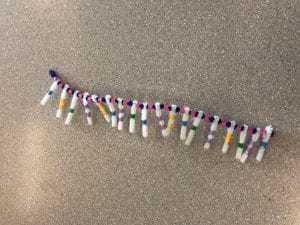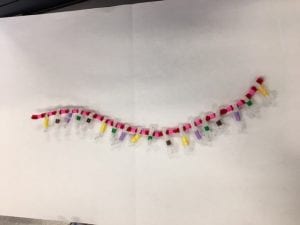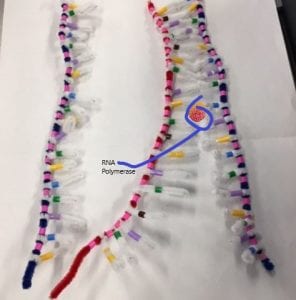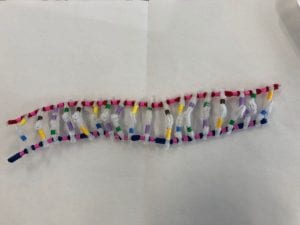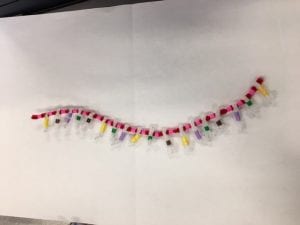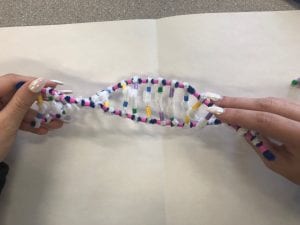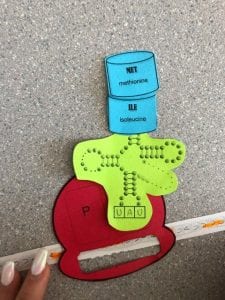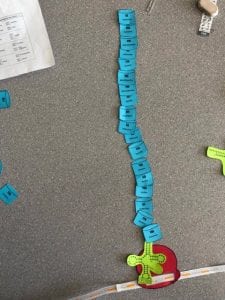1.How is mRNA different than DNA?
Although both DNA and mRNA are polynucleotides, they have three distinct differences to one another.
- Firstly, unlike DNA which is double stranded, long and has a helix; mRNA differs as it is single stranded, short and does not contain a helix.
- Secondly, DNA’s nucleotides contain the sugar deoxyribose, whereas mRNA’ nucleotides contain the sugar ribose.
- Lastly, while base pairing occurs in DNA, Adenine will always pair with Thymine. In mRNA there is no Thymine so instead Adenine will always pair with Uracil in terms of all types of RNA including mRNA.
2.Describe the process of transcription.
Transcription is the process in which one gene’s DNA sequence is copied (transcribed) onto a strand of mRNA. It occurs in 3 phases: Unwinding & unzipping of DNA, complimentary base pairing with DNA, and separation from DNA. All phases are in occurrence due to the enzyme RNA polymerase.
Phase 1: Unwinding and Unzipping
- During the process of transcription, a portion of the DNA helix unwinds and unzips, exposing one gene.
Phase 2: Complimentary Base Pairing
- Only 1 strand will be used as a template to produce an mRNA strand, this is known as the sense strand. Along the sense strand the complimentary RNA bases will bond together. Since RNA doesn’t contain Thymine, Adenine will pair with RNA’ equivalent base pair: Uracil. The sense strand partners with what is known as the nonsense strand, containing information that is not useful; not yielding a protein, if transcribed.
- RNA polymerase will join the the adjacent nucleotides to one another using H-bonds. The nucleotides will bond, forming covalent bonds and build an mRNA backbone.
Phase 3: Separation
- Once the entire gene has been transcribed the mRNA strand will detach from the DNA strand. The DNA molecule will rewind itself, reforming its double helix shape. This results in a strand of mRNA that gets modified before it moves out towards the nucleus.
How did today’s activity do a good job of modelling the process of RNA transcription? In what ways was our model inaccurate?
There were a few ways in which the activity accurately modeled the process of RNA transcription. I think that it accurately displayed how instead of pairing with Thymine Adenine will pair with RNA’ Uracil by the use of a different coloured bead, as well as the difference in their backbones, modelled using a red backbone. I think that it also gave a good representation of how the DNA and RNA bases paired with one another. We also got a good visual on how the mRNA strand and DNA strand separated from one another and how the DNA returned to its double helix shape. I think it painted a good picture of each of the 3 phases of transcription. There were two inaccuracies that I found with this activity. The activity didn’t show how the mRNA strand is much smaller to the DNA strand; nor did it show what follows after transcription occurs and how the mRNA strand is processed which was shown as an important step.
Describe the process of translation: initiation, elongation, and termination.
Translation is the process in which the code carried by mRNA transforms into a polypeptide. This process of translation occurs in 3 steps: initiation, elongation and termination.

Ribosome reaches the start codon and is instructed to start translating and to code for an amino acid
Step 1: Initiation
- In an mRNA, the instructions to build a polypeptide come in groups called codons. Codons – 3 letter words located on mRNA. There are 3 “stop” codons that mark the polypeptide as finished; and one codon, AUG, is a “start” signal that starts of translation.
- During this stage of translation, mRNA binds to the small ribosomal subunit in the area of the start codon (AUG). The first tRNA pairs with this codon. A large ribosomal subunit and small subunit will then join together.There are two sites in the ribosome in which bonding can occur, the “A-site” and “P-site”. The ribosome will then start to move along the mRNA until it reaches the start codon, AUG, in the “P-site”. This tells it to start translating and code for an amino acid. A matching tRNA will bring in an amino acid that is represented by the mRNA codon.
Step 2: Elongation
- A ribosome is large enough were it can contain two tRNA molecules: the incoming and outgoing. tRNA also contains 3 letter codes called anticodons which are complimentary to mRNA codons.
- During this step the ribosome will hold the mRNA and allow for the complimentary tRNA to attach to the binding sites. As the tRNA binds to the “P-site” , another will bond with the “A-site”. A peptide bond will form between the two amino acids. Thi bond causes the amino acids to let go of the tRNA in the “P-site” and start to bind to the neighbouring amino acids. The “empty” tRNA will then leave the ribosome and as a result the ribosome will begin to move along the mRNA. This is done in order to make the tRNA that contains the polypeptide chain shift over to the “P-site”. Now the second tRNA is at the “P-site” and the new tRNA will start to bind with the mRNA codon at the “A-site”.
Step 3: Termination
- The elongation cycle will continue until the mRNA reads a stop codon, terminating the process. This would be a 3 letter word (codon) with no matching tRNA amino acid. This means that there are no new amino acids being added to the chain, causing the ribosome to separate into its two subunits and release the polypeptide.
How did today’s activity do a good job of modelling the process of translation? In what ways was our model inaccurate?
The ways that this activity was accurate was that it went through each of the stages carefully, allowing for one to grasp the concept better. We also got to see how the ribosome moves along the chain. I also found it beneficial to see how the codons and anticodons paired with one another. Some things that I found to be inaccurate with this activity was that we weren’t able to model the release factor that bonds to the stop codon and how the polypeptide is detached. I also found that the changing of the tRNA’ shape wasn’t displayed nor was the accurate shape of the amino acids displayed well.
